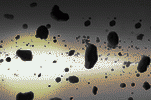|
Article 6 of 6 on Studying the Moon Observing the Age of the Moon and Its Craters Michael Packer Comments: m·DOT·packer·AT·Yahoo·DOT·com |
|
Amateur astronomers like to know the
basic facts of deep sky objects they observe - distance, age, size, a property
that makes the object noteworthy. The same thing goes for the Moon and its
features. But age, one of the most important data points for understanding
lunar terrain (and the major impact events in the inner solar system for that
mater), is hard to recall both because there are a lot of lunar features to
remember and no good method presented on recollecting them. This article on
studying the Moon tries to solve this dating puzzle by first reviewing the formation of the Moon, presenting the a 6 Major Lunar Epochs that date important features and finally listing the Dates Of Craters worth remembering.
The Lunar Age Story: A cataclysmic
collision between a Mars sized body scientists have come to call Theia and a
proto-Earth is the best model that fits the conditions of our 12,700 km planet
having a relatively large 3500 km moon. The impact theory was first proposed in
the 1940’s and gained new life after rock samples were brought back to Earth.
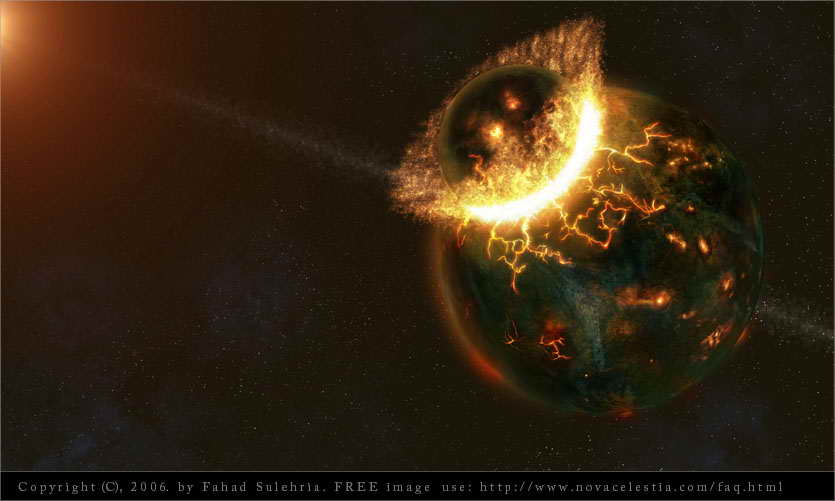
The collision with Theia likely marked
the final stages of planetary accretion across the solar system and contributed
roughly to the last 10% of Earth’s mass. Ancient lunar rocks are dated to
4.56–4.29 Gyr (Gyr = billion years). But the exact age of the
Moon is unknown.
Both the rock samples and computer
impact scenarios, that meet the high angular momentum conditions of the
Earth-Moon system, suggest that the Moon formed mostly from the mantles
surrounding the iron cores of Earth and Theia. What was left was a molten
Earth, rich in heavy and light elements, and a molten Moon, iron deficient and
gravitationally unable to hold on to the many light gaseous volatiles (such as nitrogen,
water, carbon dioxide, ammonia, hydrogen, methane) that persisted before it
cooled. The Moon was a globular magma ocean. It became Earth’s satellite continent
but it was destined to be a gray volcanic badlands.
Not too gray of a place for geologists
however. As the Moon cooled, the fraction of heavy elements that remained
crystallized into iron and magnesium silicates and sank. Less dense material
then crystallized, floated and formed an anorthositic crust about 50 km in
thickness. For what it’s worth, this anorthositic rock is composed of more than
90% calcic plagioclase feldspar which means “calcium-rich oblique fracture
shaped crystalline minerals” an example of which is CaAl2Si2O8. But the point
is that this chalk looking rock represents the original crust of the moon and,
after billions of years of horrendous impacts, it can still be recognized all
over the lunar surface. It has a high albedo and makes up the bright white
terrae or lunar highlands (Example: southern highlands around Tycho). It
contrasts markedly with the dark iron-rich basaltic maria - the lava seas or
extrusive magma that found its way to the surface a billion years later by
erupting through the floors of the impact basins.
Six Lunar Epochs: Mentioning maria
moves this age story to the epochs of cratering. And once again to the delight
of geologists, a badly cauterized moon would suitably record the major impact
episodes right up to the present day. This enduring impact record continues to
aid planetary geologists’ understanding of how solar system bodies were formed,
or transformed, into their present state.
Maps of the 6 epoch impacts make a great observing plan for an evening.
Source: http://ser.sese.asu.edu/GHM/ghm_hplates.html.
Source: http://ser.sese.asu.edu/GHM/ghm_hplates.html.
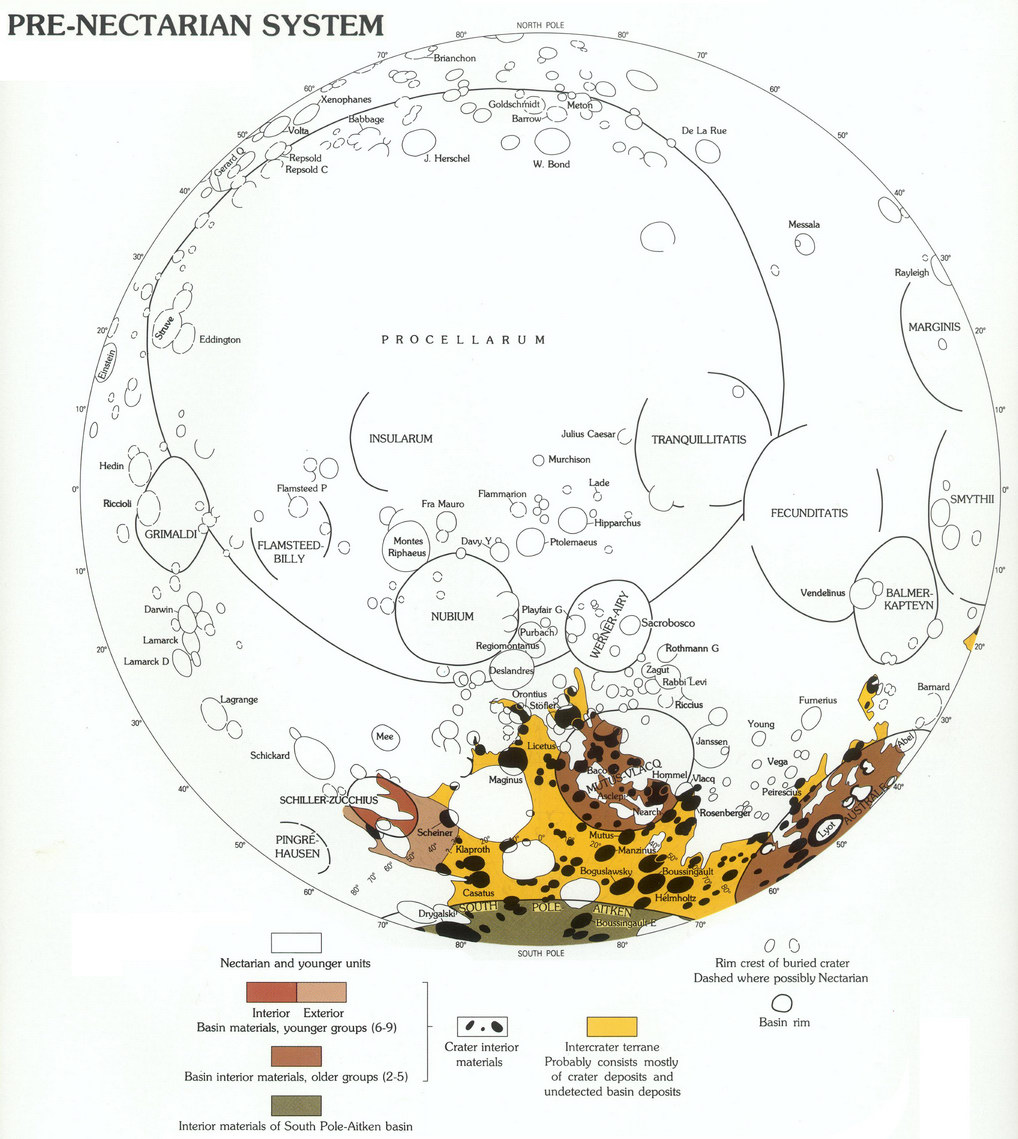
|
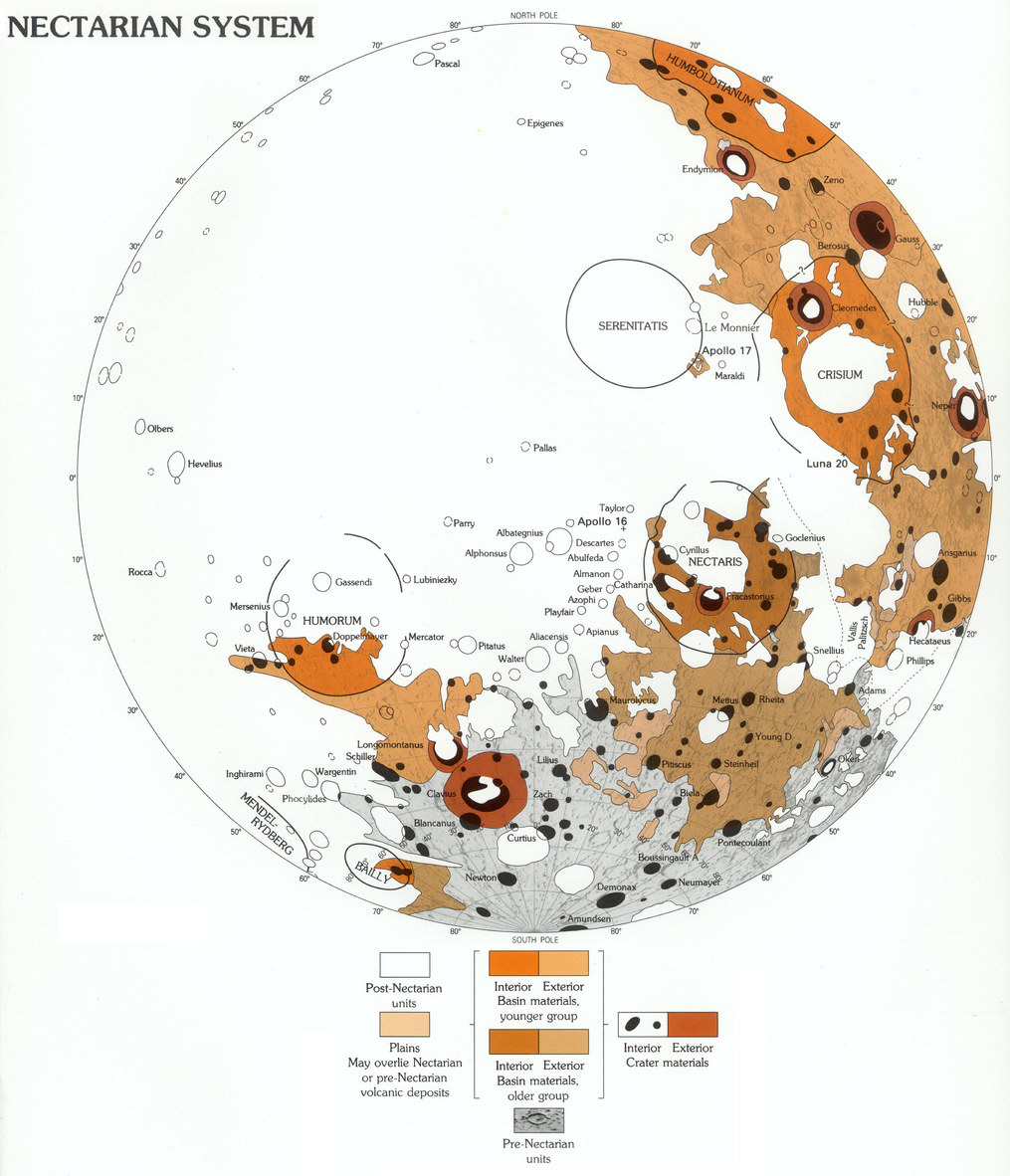
|
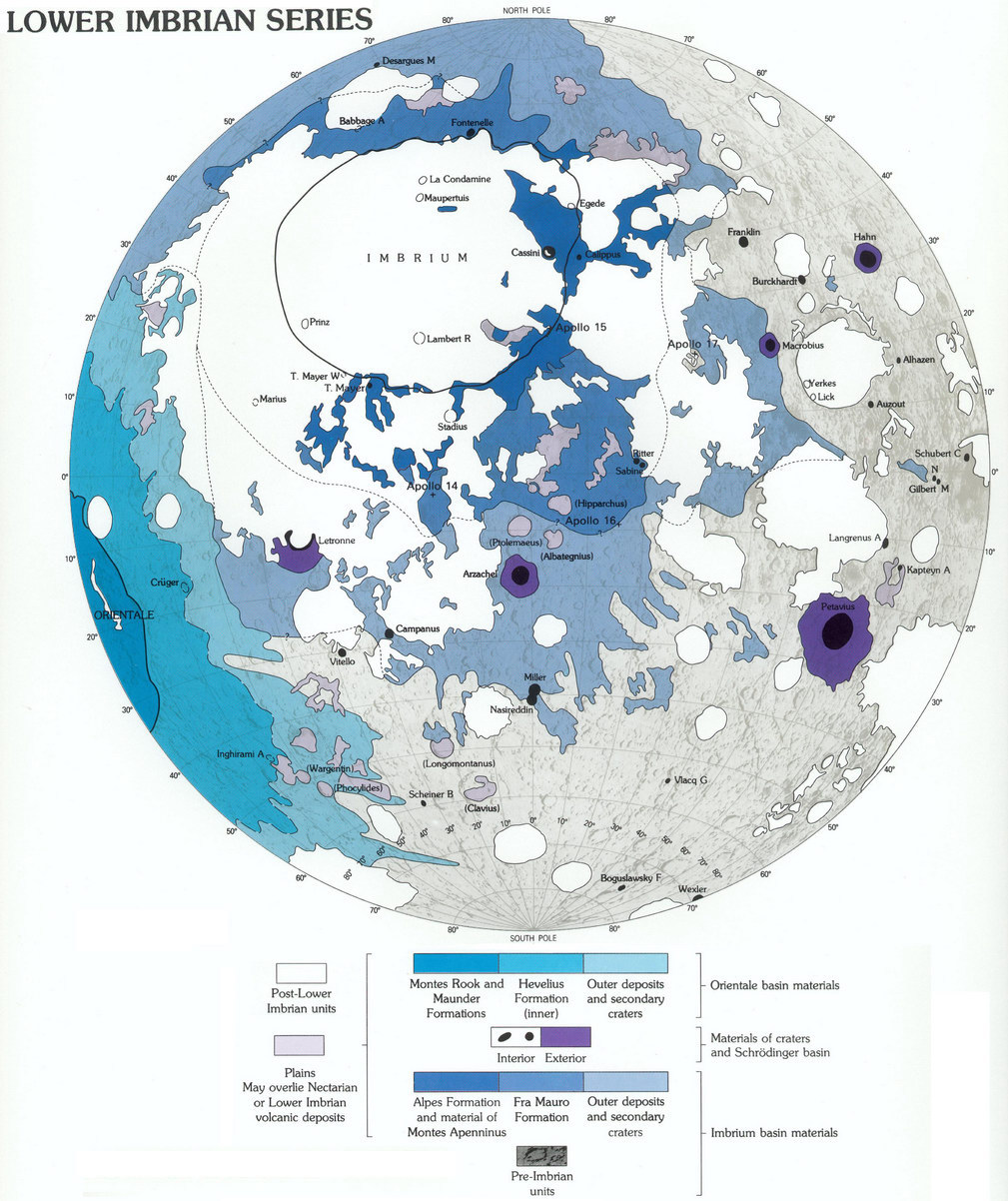
|
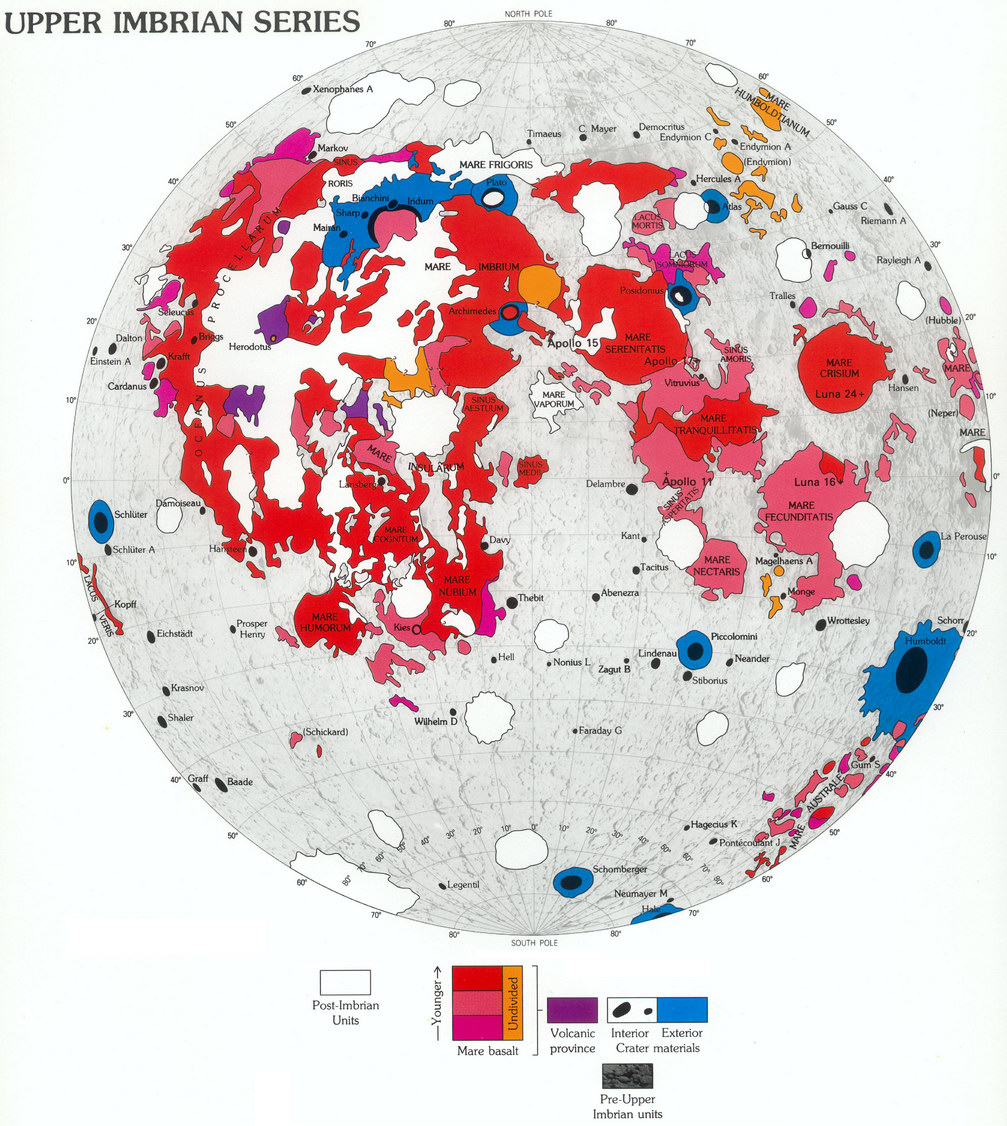
|
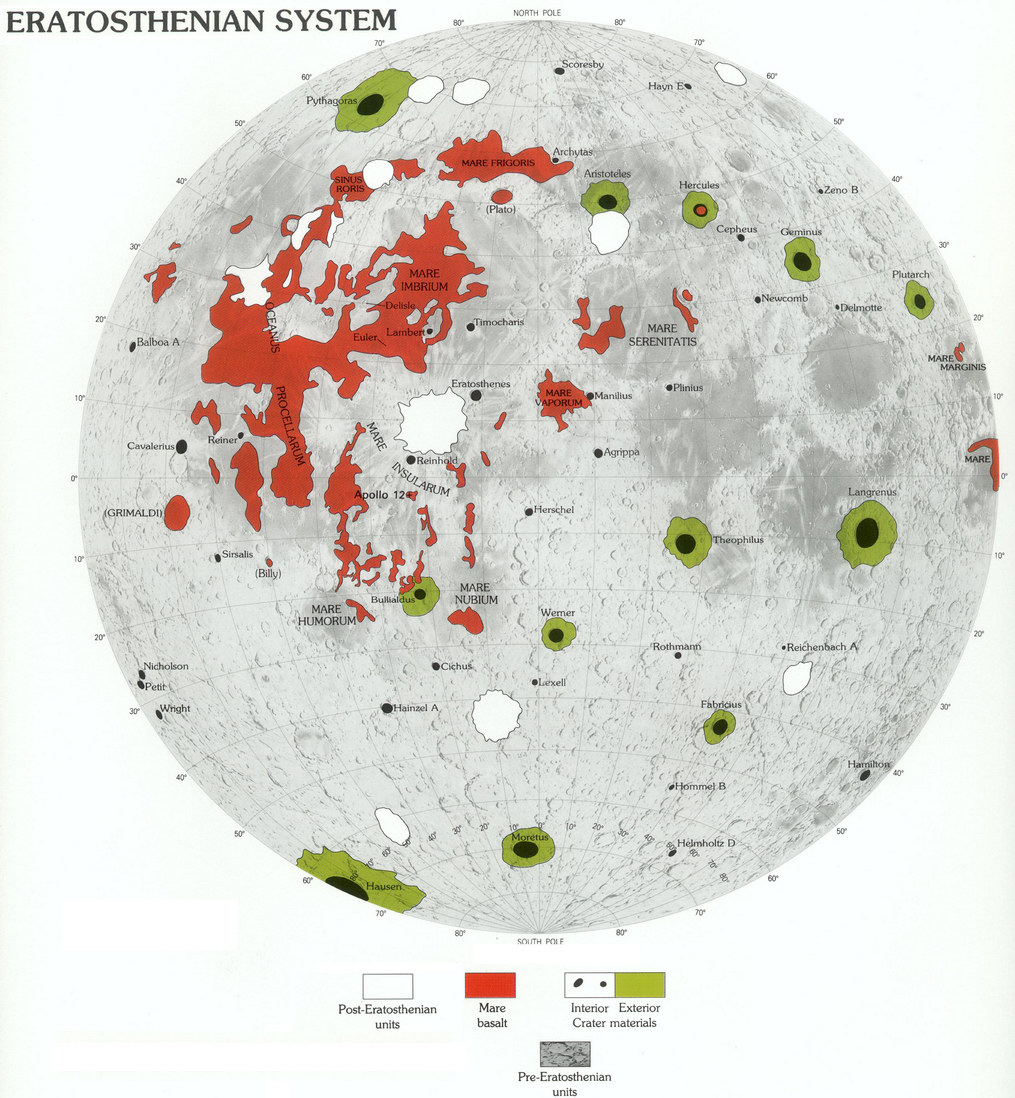
|
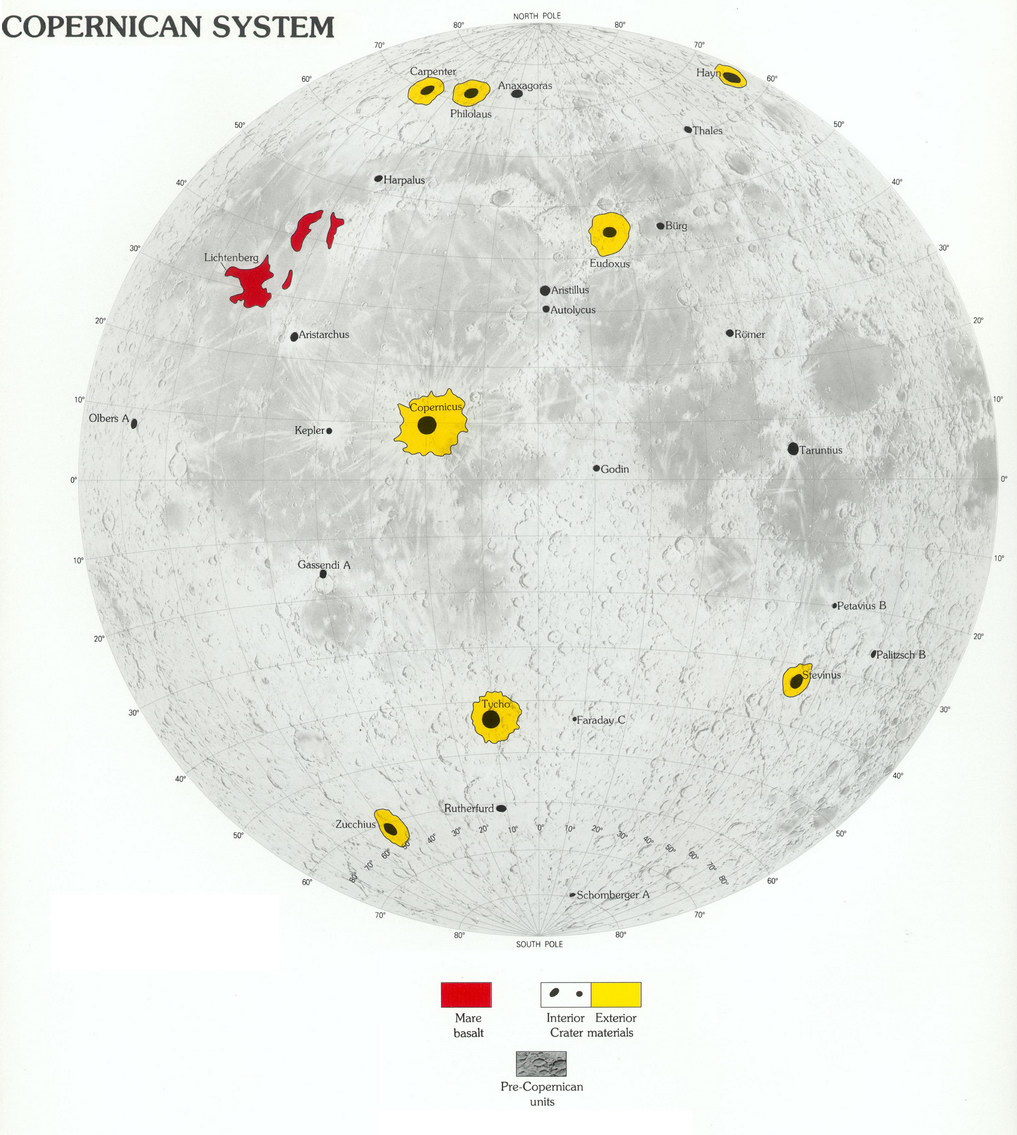
|
4.53 to 3.92 Billion Years |
3.92 to 3.85 Billion Years |
3.85 to 3.75 Billion Years |
3.75 to 3.2 Billion Years |
3.2 to 1.1 Billion Years |
1.1 to Present Day |

|
|
A crater for each epoch. Compare the poor deffinition of crater rims for oldest craters left to progressively fresher craters right. |
Pre-Nectarian: 4.53 to 3.92 Gyr
The Pre-Nectarian period is defined from
the point at which the lunar crust formed to the time of the Nectaris impact
event. The Pre-Nectarian period started within an intense cratering period
associated with the accretion of the Moon. Fragments of ruined craters on the
Moon are the oldest and most difficult to recognize. The impact basins
Procellarum, Tranquillitatis, and Fecunditatis likely formed in this epoch.
Their basin walls are respectively demolished.
Nectarian: 3.92 to 3.85 Gyr
The Nectarian period is named for the impact
basin that contains the relatively small Mare Nectaris, which is one of about
12 multi-ring basins that formed in this brief interval. This epoch likely
corresponds to the Late Heavy Bombardment period of the inner solar system.
These old basins are all heavily degraded by subsequent impacts.
Lower Imbrian: 3.85 to 3.75 Gyr
The short interval beginning with the
Imbrium impact and ending with the Orientale impact is called the Lower Imbrian
period. The formation of the Imbrium and Orientale basins provides the most
important and widespread stratigraphic boundary between the ancient, heavily
cratered Moon and the more recent Moon dominated by lava flows and a great
reduction in impact cratering.
|
||||||||||||||||||||||||||||||||||||||||||||||||||||||||||||
Upper Imbrian: 3.75 to 3.2 Gyr
2/3's of the Moon's mare basalts erupted
within the Upper Imbrian with many of these lavas flows filling the impact
basins. What did not crystallize and sink or crystallize and rise in the
formation of the moon remained in a magma state. This material called KREEP is
rich in rare-earth elements including uranium and thorium. Consequently
radioactive heating was believed to be intense during this time and is
attributed to the formation of most of the lunar maria particularly around
Imbrium and Procellarum. It should be noted however that an interesting
flooding theory, aside from the above, postulates that a major far-side impact
sent shockwaves through the moon and instigated massive magma flooding on the
near side - much in the same way that a rock striking an outside car windshield
transfers energy and blows off a cone shaped piece of glass on the inside of
the car [1].
Eratosthenian 3.2 to 1.1 Gyr
After the core formation of lunar seas,
the Eratosthenian period is demarked by fresh looking craters with no impact
blemishes but with no rays structure either. Eratosthenes crater is a reference
example. This was the longest period in Lunar history. During this era,
late-stage volcanism still filled low-lying regions in and around Mare Imbrium
and Oceanus Procellarum. Consequently secondary craters from some Eratosthenian
impact craters are flooded or embayed by mare lavas. Bright ray systems would
have undergone space weathering and faded away over the long 3 billion year (to
present day) time scale.
Copernican 1.1 to Present Gyr
Copernican period is demarked by fresh
craters with rays. The Copernicus impact (.800 Gyr) itself is a large impact
with well defined walls, central peaks, secondary impacts, extensive ejecta and
a well defined ray system. It has all the fresh detail of a relatively new
impact. We are currently in the Copernican period of lunar history. There are
no definite mare lava flows in this era but small numbers of superposed impact
craters suggest that a few lava deposits in northern Oceanus Procellarum are of
Copernican age. The most significant geologic activity on the Moon during the
Copernician period has been the continuing (but infrequent) impact cratering.
The Copernican craters Tyco (.108 Gyr) and Chicxulub (.065 Gyr) on Earth are
believed to be formed form a group of
asteroids called Baptistina which itself was created from a collision
within the Asteroid Belt about 160 million years ago (.160 Gyr). The Chicxulub
crater has been strongly linked to the extinction of the dinosaurs 65 million
years ago. Hence Tycho is known as the Dinosaur crater by its association with
Chicxulub.
Observing The Age Sequence Of Lunar Terrain: Archimedes, Autolycus and Aristillus: Grouped together in the northeastern
sea of Mare Imbrian lie the craters Aristillus (northeast), Autolycus (middle)
and Archimedes (southwest). With a
diameter of 55 km, Aristillus is a complex crater. It has terraced
walls, a crenulated rim, a large flat floor and a massive clump of central
peaks. It is also fairly easy to see that Aristillus is a fresh crater with a
well defined wall, central peak system and bright rays of ejecta. It therefore
is a Copernician period crater, under 1.1 billion years old.

The middle crater Autolycus is a little
more tricky to pin down. Sitting on the bench of the nearby Apennine Mountains,
39 km Autolycus is smaller crater with less complex morphology. It does not have a
discernable central peak but does have a floor filled with lava material and
collapsed wall debris. Age wise, Autolycus shows distinct signs
of erosion around its wall particularly to the north. Inspection with a
telescope at or near the terminator shows radiating debris from Aristillus
draping over Autolycus’s outer structure. On the other hand, high angled light
observations show that Autolycus has a faint ray structure itself - part of
which lies over Archimedes. Hence Autolycus is likely a Copernician period
crater, younger than Archimedes but older than Aristillus.
83 km Archimedes (flat floored and only 1.6
km deep) seemingly does not fit within the crater size scale. Its floor should be
more like 4 km deep and have a peak system 2 km high. It was recognized early
on that it, and Plato 600km north, must be partially filled with mare lavas
from the Imbrium basin. And in fact, shadows cast from Archimedes rim on its
floor and surrounding mare show the lava inside is about the same level as the
lava outside. There are no breaches around the rim of Archimedes so the lava must have risen through fractures in the floor of the crater. Since
Archimedes-sized craters are 4 km deep (not 1.6 km) these means that 2.4 km of
lava filled the crater and buried its 2 km peak system. That’s why it’s not
there!
Pulling these observations together in
context with the 6 epochs, a chronology of this area can be assessed. 3.85
billion years ago the Imbrium basin formed creating the Apennine Mountains. A
billion years later, basaltic lava filled the basin. But sometime in between these
two events the Archimedes crater formed and its floor was subsequently flooded
along with the Imbrium basin. After the flooding, at least two billion years passed by before the Autolycus impact crater formed and then, sometime later, the Aristillus
crater formed.
These kind of observations taken in context of the epochs (which in turn were estimated with the aid of lunar rock samples) can allow amateur astronomers to better recount the age of the terrain they’re seeing and sharing at the scope. It takes some practice, but after a while the countless detail in the Moon's surface is replaced by a story told by a more manageable number of craters and maria. The age of the lunar surface gives one a profound sense of inner solar system development dating back 4.5 billion years. And our connection with this detached land mass may be thought of as a remote continent rather than a unrelated satilite. Thanks for sharing my interest in studying the Moon. (Sources:
Chuck Wood’s LPOD and book, various articles on the net including "The Geologic History of the Moon" by Don Wilhelms and the Virtual Lunar
Atlas)
